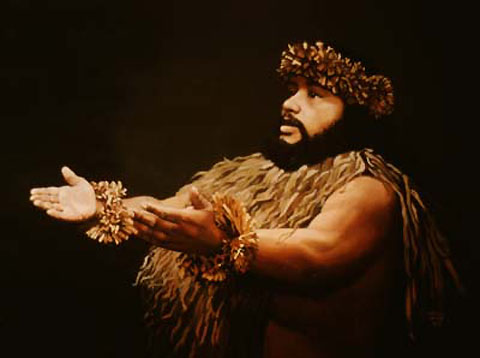SUBJECT: HAWAIIAN LANGUAGE
SOURCE: JUAN WILSON juanwilson@mac.com
POSTED: 18 FEBRUARY 2007 - 1:00pm HST
Lesson
#1: Intro to Conversational Hawaiian

"Olapa de Leon" by Edwin Kayton. See his
work at www.kayton-art.com
|
by
Juan Wilson & Linda Pascatore on 18 February 2007 We are planning on making things we have learned in the class available on this website. We do not claim to be speakers of Hawaiian language, and do not claim that our lessons learned are accurate. Moreover, as Kamakua indicated in her first class, Hawaiian spoken on Niihau differs from the formal classes of Hawaiian taught at the university level. Not only is the vocabulary different, the punctuation is different as well. The Hawaiian alphabet was largely determined by English speaking explorers and missionaries who tried to write down the phonetic sounds they heard Hawaiians speaking. The modern results are as follows: The Hawaiian vowels: A
=
(ah) as in ma The Hawaiian consonants have meaning only in relationship to the vowels. So when spelling out a word like HULA one would say H=hu, U=u, L=la and A=a,or hu u la a The
Hawaiian consonants: It is our opinion that many subtleties were likely lost and that this has resulted in a written record that is poorer that the original spoken language. There are a few hints of the loss. One is the question of whether the W sounds like "wha" or "va". In our class it is "va". Another anomaly we have noticed is that in early translations of spoken Hawaiian the "H" is often written interchangeably with "K". Could "Kauai" and "Hawaii" be the same word misunderstood by these early listeners? Written Hawaiian includes two accent marks to specify how vowels are to be treated. One is the okina ( ` ), which is used between vowels, like a hyphen to separate the sounds of vowels so that that are not blended together, The other is the macron ( – ) used over a vowel to show it is emphasized. Any written word that starts with a vowel should be preceded by an okina. Although silent, the okina is considered in formal Hawaiian one of the vowels. These marks are commonly not used by native Hawaiian speakers on Niihau. Kamakua told us that when speaking Hawaiian, Niihauans know, by context, where to make a separation or emphasis. When writing Hawaiian she often does not include marks unless strongly needed. As as result, we warn readers that our use of these accents are not fully accurate or consistent. Because of the nature of the limitations of the web to display typographical symbols we have decided to try and use the apostrophe ( ' ) in place of the okina and an underline of a letter ( a ) rather than a macron. It should be noted that in conversational Hawaiian in our class Kamakua uses many contractions and blends that make it easier to speak the language, but that may conflict with strict written Hawaiian and our ability to express it properly. Another concession to clearer understanding that we have made in our class notes have been on occasion to separate a word into two parts with a hyphen ( - ). This unconventional notation has been useful in understanding underlying structure of some word elements that are used in multiple settings. For example we will end this lesson with counting from one to ten and comparing that count with the days of the week. Numbers 1
= 'ekahi ('e-kahi) kahi = alone, together as unit,
spouse The days of the week follow the seven day tradition of the Europeans and Americans that came to the islands. The Hawiians measured a day as overnight (po), a period of 24 hours beginning sunset (the Hawaiian “day” began at nightfall) Weekdays |

Lesson #2 Counting and Dates
Pau